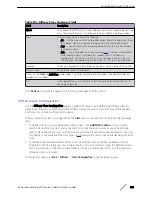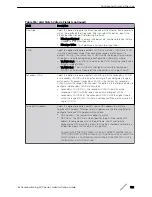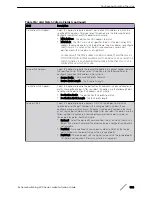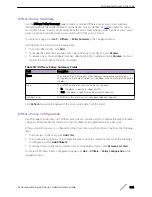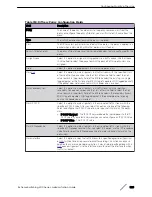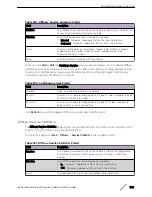
To display the Interface Queue Configuration page, click
QoS
>
Class of Service
>
Queue
in the
navigation menu.
Table 312: Interface Queue Configuration Fields
Field
Description
Interface
Specifies the interface (physical,
, or Global) to
configure.
Minimum Bandwidth Allocated Shows the sum of individual Minimum Bandwidth values for all queues in the
interface. The sum cannot exceed the defined maximum of 100. This value is
considered while configuring the Minimum Bandwidth for a queue in the
selected interface.
Queue ID
Use the menu to select the queue per interface to be configured.
Minimum Bandwidth
Specify the minimum guaranteed bandwidth allocated to the selected queue on
the interface. Setting this value higher than its corresponding Maximum
Bandwidth automatically increases the maximum to the same value. The default
value is 0. The valid range is 0 to 100, in increments of 1. The value zero (0)
means no guaranteed minimum. The sum of individual Minimum Bandwidth
values for all queues in the selected interface cannot exceed defined maximum
100.
Scheduler Type
Selects the type of queue processing from the drop-down menu. Options are
Weighted and Strict. Defining on a per-queue basis allows the user to create the
desired service characteristics for different types of traffic.
•
Weighted: Weighted round robin associates a weight to each queue. This is
the default.
•
Strict: Strict priority services traffic with the highest priority on a queue first
Queue Management Type
Displays the type of queue depth management techniques used for all queues
on this interface. This is only used if the device supports independent settings
per-queue. Queue Management Type can only be Taildrop. The default value is
Taildrop. All packets on a queue are safe until congestion occurs. At this point,
any additional packets queued are dropped.
•
If you make changes to the page, click
Submit
to apply the changes to the system.
•
Click
Restore Defaults for all Queues
to reset the settings for the selected interface.
•
To reset the defaults for all interfaces, select Global from the Slot/Port menu before you click the
button.
Configuring Diffserv
Use this page to configure the administrative mode of Differentiated Services (DiffServ) support on the
device and to view the current and maximum number of entries in each of the main DiffServ private MIB
tables. DiffServ allows traffic to be classified into streams and given certain
treatment in
accordance with defined per-hop behaviors.
Packets are classified and processed based on defined criteria. The classification criteria is defined by a
class. The processing is defined by a policy's attributes. Policy attributes may be defined on a per-class
instance basis, and it is these attributes that are applied when a match occurs. A policy can contain
multiples classes. When the policy is active, the actions taken depend on which class matches the
packet.
Configuring Quality of Service
ExtremeSwitching 200 Series: Administration Guide
317

















